Winter Birding with Birds of Poole Harbour: Delving into Diver Identification
There was a lovely first calendar year Black-throated Diver along with 3 Great Northerns in Whitley Lake off Shore Road this morning. With a respectable total of 8 Great Northern Divers recorded across the Central Harbour, South Deep and North Channel today, it only seemed fitting for today's winter birding article to focus on Divers...
Summer-plumaged divers are among the smartest visitors to our waters and are readily identifiable. Unfortunately, the same cannot be said for the understated non-breeding plumages these birds adopt during the winter months. The dapper summer throat patches are exchanged for a rather less distinctive appearance. That said, swimming birds can usually be identified confidently with careful study of bill structure, colour and head, neck and flank details.
Over recent months, passage migrants and returning winter species of various shapes and sizes have been arriving back for the season. As well as worrying about the prospect of separating the divers, a supporting cast of cormorants, auks, grebes and ducks can add to the confusion.
Divers have a very distinctive ‘humpbacked’ flight profile, with long, narrow wings, large protruding feet that trail and powerful, direct flight action. Birds are typically observed singly but sometimes in loosely scattered, small parties and often fly well above the horizon. All have plain wings, which instantly separates them from grebes. Separating diver species in flight can be difficult, and distant or doubtful individuals should be identified with great caution. Grebes can be ruled out quickly as the weaker fliers typically travel low over the water, with trailing feet, with fast wing beats.

Great Northern Diver in flight silhouette © Ian Ballam
Divers usually sit low in the water (like cormorants, unlike ducks), but float higher when resting or preening, appearing long-bodied, long-necked and ‘tailless’. A very easy behavioural distinction from Cormorant and Shag is that divers do not leap out of the water to dive underwater. Instead, they gently bow their head forward and submerge with a smooth elegance, often remaining submerged for over a minute, moving surprisingly long distances underwater. Diving may follow a period of underwater surveillance (or ‘snorkelling’) with the bill and head partly submerged in the water.
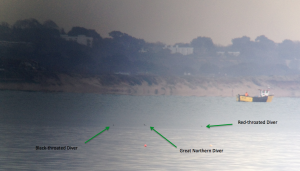
Record shot of all three diver species at Studland, December 15 2014.
Of the three species that regularly occur in the UK, two are scarce breeders in Scotland (Red-throated & Black-throated), becoming widespread during the winter and the other (Great Northern) a regular winter visitor. Red-throated Diver are best searched for out in Poole Bay and Studland Bay where numbers are generally between 1-4 birds during the winter. Higher counts can occur during periods of bad weather as they move around to find more sheltered areas. In the winter, best places to look are out in Poole Bay, Shell Bay and Studland Bay with occasional inner harbour records at places like Brands Bay and even Holes Bay and Lytchett Bay. Passage birds move through Poole Bay in an easterly direction in the spring and westerly in Autumn and on days of strong passage up to 20 birds can be logged. George Green in Birds of Dorset does mention mid winter movements and highly mobile winter birds. The record maximum is 34 in Poole Bay on Christmas Day 1988, with the previous record being twelve counted flying in to the harbour, again on Christmas day 1984.
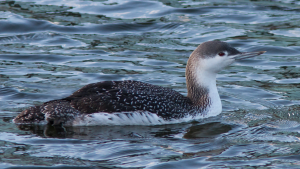
Red-throated Diver in winter plumage
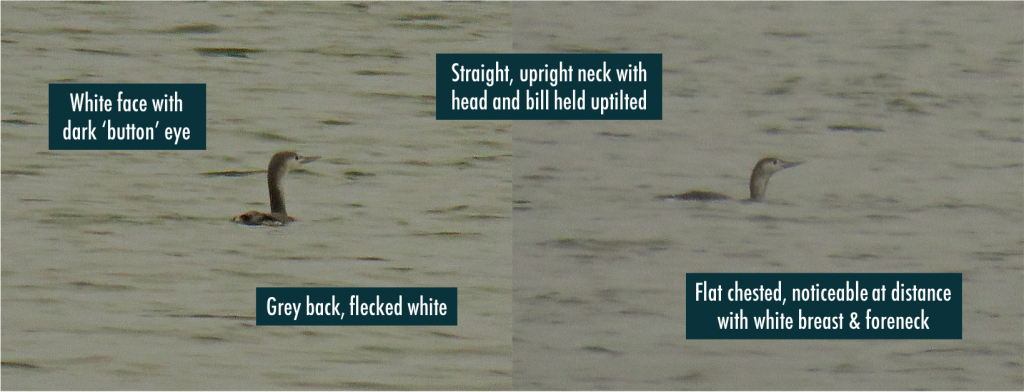
Red-throated Diver Identification. Photo © Ian Ballam
Great Northern Diver are most common of the three regular diver species found inside and outside of the harbour. Outside they can be seen out in Poole Bay, whilst inside the harbour they prefer the deep channels around Brownsea, Brands Bay and the harbour mouth. Birds can also be encountered off the beaches at Shipstal, Hamworthy, Baiter and Shore Road on cold, still winter mornings, and have even turned up on Poole Park boating lake in recent years! Numbers tend to peak after sustained periods of bad weather, forcing birds to enter the harbour in search of shelter. The wet and windy winters of 2013/14 and 2019/20 saw harbour records broken each time with a high count of 16 around the harbour on February 12th 2017 and 19 logged during the Big Poole Harbour Bird Count back in January 19th 2020.
Passage occurs out in Poole Bay in autumn and spring and some full summer plumaged birds have even been logged sat out on the water in Poole Bay during May and early June. The autumn was a great year for passage birds, with up to 6 Great Northern Divers frequently recorded in October and November, of which 2 were in stonking summer plumage! First-winter birds closely resemble non-breeding adult plumage, but are separable at close range by detailed head pattern and pale fringing on upperparts forming a neat scalloped pattern.
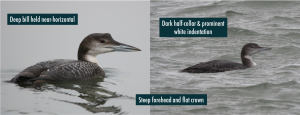
Great Northern Diver Identification. Photo (left) © Clare Slade
Black-throated Diver are the least common of the three ‘regulars’, they can arrive and spend time in the bays outside the harbour mouth during the winter. They are scarcely recorded inside the harbour, when present the north channel off Evening Hill and Salterns Marina seems most favourable. In winter, birds can be also be found fishing off Sandbanks just outside the harbour mouth and into Studland Bay, with a maximum of 8 in Poole Bay 7th January 1989, however most records are logged from winter seawatches from Branksome Chine. Unseasonal historical records include individuals on 31st July 1978 and 13th June 1984. One also summered in Poole Bay in 2000 and was present from June to September seen mainly off Branksome Chine. One on Hatch Pond 21-23 January 1995 was a noteworthy inland record.
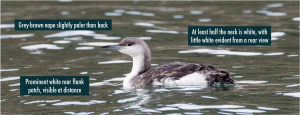
Black-throated Diver Identification
You might also like...
Harbour Update – posted 26/07/24
It was good to get that dank, yucky murk out of the way, which allowed for some new…
Find out moreHarbour Update – posted 25/07/24
You should never right off a good days birding because of the weather, because you just never know….
Find out moreCall 01202 641 003
© 2024 Birds of Poole Harbour Registered Charity No. 1152615
